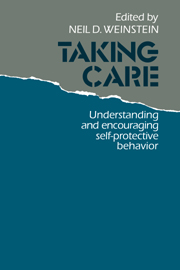Book contents
- Frontmatter
- Contents
- List of contributors
- Acknowledgments
- Introduction: studying self-protective behavior
- I Theoretical perspectives
- II Research and prevention programs for specific hazards
- 6 Why people take precautions against health risks
- 7 Community studies of smoking cessation
- 8 Preventing adolescent smoking
- 9 Natural hazards and precautionary behavior
- 10 Programs that encourage the adoption of precautions against natural hazards: review and evaluation
- 11 Why people take precautions against crime: a review of the literature on individual and collective responses to crime
- 12 Promoting citizen involvement in crime prevention and control
- 13 Injury prevention: limits to self-protective behavior
- 14 Perspectives on protective behaviors and work place hazards
- III Conclusion
- Index
13 - Injury prevention: limits to self-protective behavior
Published online by Cambridge University Press: 03 February 2010
- Frontmatter
- Contents
- List of contributors
- Acknowledgments
- Introduction: studying self-protective behavior
- I Theoretical perspectives
- II Research and prevention programs for specific hazards
- 6 Why people take precautions against health risks
- 7 Community studies of smoking cessation
- 8 Preventing adolescent smoking
- 9 Natural hazards and precautionary behavior
- 10 Programs that encourage the adoption of precautions against natural hazards: review and evaluation
- 11 Why people take precautions against crime: a review of the literature on individual and collective responses to crime
- 12 Promoting citizen involvement in crime prevention and control
- 13 Injury prevention: limits to self-protective behavior
- 14 Perspectives on protective behaviors and work place hazards
- III Conclusion
- Index
Summary
Introduction
Injury is generally underestimated as a health problem and overestimated as a behavioral problem. Injury ranks third as a cause of death per capita, but this statistic is somewhat misleading because of the large impact of injury on the young. Although heart disease and cancer kill more people in total, the median ages at death – 76 for cardiovascular disease and 68 for cancer – suggest that prevention of these deaths would add less to the preservation of life than the total deaths due to those causes would suggest. In contrast, the median age at death from motor vehicle injury is 27 and that from other unintentional injuries is 50. For homicide and suicide, it is 31 and 42, respectively. Injury is the leading cause of loss of productive years of life.
Injury accounts for about 150,000 deaths per year, some 65 million physician contacts, and 3.6 million hospitalizations. Injury is the leading cause of death and hospitalization among persons 1 to 44 years old (Baker, O'Neill, & Karpf, 1984).
Traditionally, injury was thought to be a behavioral problem, and little consideration was given to causes other than behavior. Trains were a major hazard in the nineteenth century, but some railroad companies delayed for up to 40 years the adoption of risk-reducing equipment – automatic couplers, braking systems, and signaling systems. One of their major arguments was that railroad worker behavior had to be changed to reduce risk (Adams, 1879; Robertson, 1983).
- Type
- Chapter
- Information
- Taking CareUnderstanding and Encouraging Self-Protective Behavior, pp. 280 - 297Publisher: Cambridge University PressPrint publication year: 1987
- 4
- Cited by



